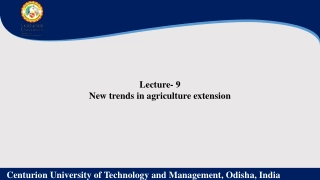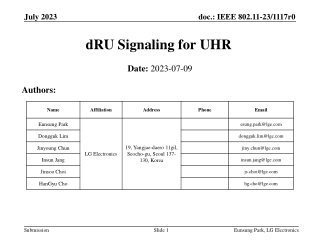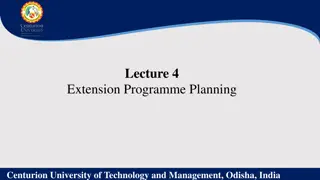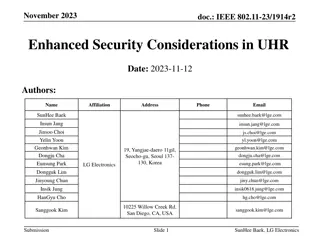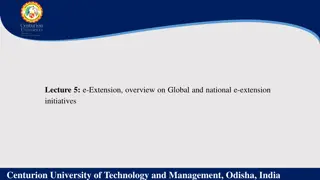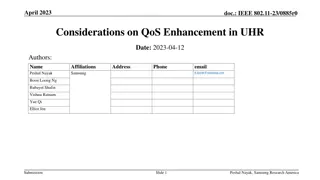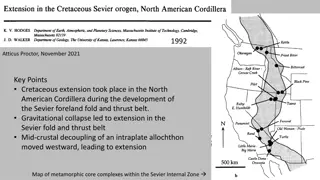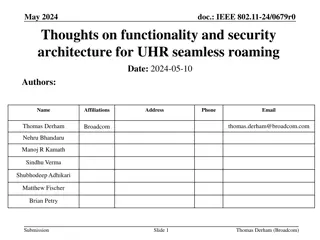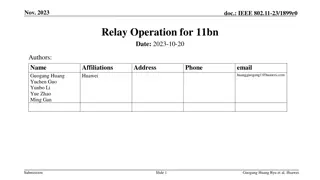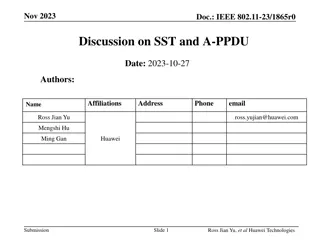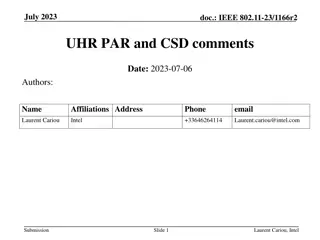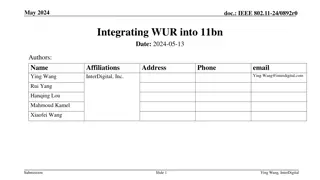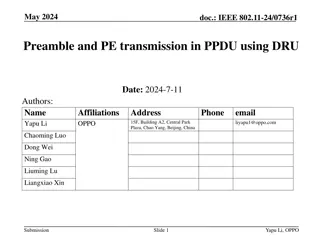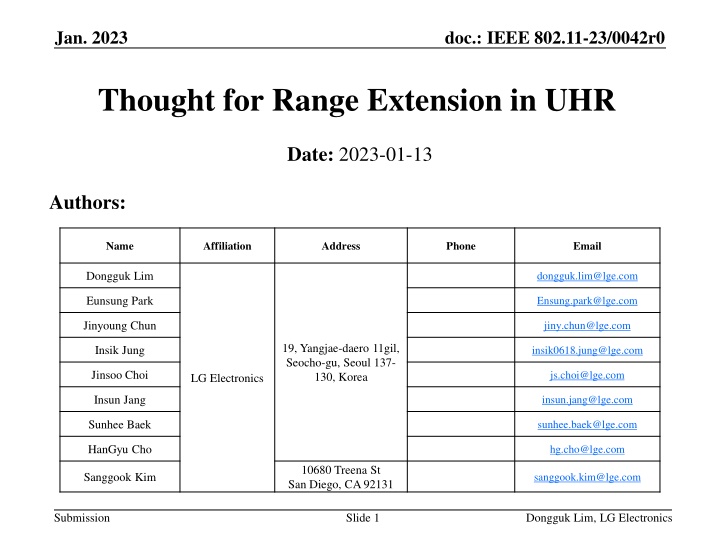
Enhancing UHR Coverage: Candidate Technologies for Range Extension
Explore how to improve reliability and throughput in Ultra High Reliability (UHR) coverage by considering range extension technologies. Discover candidate techniques like repeated transmission, multi-AP operation, and relay transmission to enhance UHR performance. Gain insights into the challenges and considerations for implementing these technologies in real-world scenarios.
Download Presentation

Please find below an Image/Link to download the presentation.
The content on the website is provided AS IS for your information and personal use only. It may not be sold, licensed, or shared on other websites without obtaining consent from the author. If you encounter any issues during the download, it is possible that the publisher has removed the file from their server.
You are allowed to download the files provided on this website for personal or commercial use, subject to the condition that they are used lawfully. All files are the property of their respective owners.
The content on the website is provided AS IS for your information and personal use only. It may not be sold, licensed, or shared on other websites without obtaining consent from the author.
E N D
Presentation Transcript
Jan. 2023 doc.: IEEE 802.11-23/0042r0 Thought for Range Extension in UHR Date: 2023-01-13 Authors: Name Affiliation Address Phone Email Dongguk Lim dongguk.lim@lge.com Eunsung Park Ensung.park@lge.com Jinyoung Chun jiny.chun@lge.com 19, Yangjae-daero 11gil, Seocho-gu, Seoul 137- 130, Korea Insik Jung insik0618.jung@lge.com Jinsoo Choi js.choi@lge.com LG Electronics Insun Jang insun.jang@lge.com Sunhee Baek sunhee.baek@lge.com HanGyu Cho hg.cho@lge.com 10680 Treena St San Diego, CA 92131 Sanggook Kim sanggook.kim@lge.com Submission Slide 1 Dongguk Lim, LG Electronics
Jan. 2023 doc.: IEEE 802.11-23/0042r0 Introduction To improve the reliability and enhance the throughput in the UHR(i.e. Ultra High Reliability) coverage, we can consider the range extension for the UHR. The potential technologies have been proposed in [1-2] to achieve the range extension in UHR. In this presentation, we investigate the candidate technologies for range extension and consider the technical direction for the object of that. Submission Slide 2 Dongguk Lim, LG Electronics
Jan. 2023 doc.: IEEE 802.11-23/0042r0 Candidate technologies for range extension For the range extension, the following technologies can be considered candidate techniques. Repeated transmission Multi-AP operation Relay transmission In the next slides, we will provide more details for each of the candidates above. Submission Slide 3 Dongguk Lim, LG Electronics
Jan. 2023 doc.: IEEE 802.11-23/0042r0 Repeated transmission It is very simple and conservative way used to extend the range and enhance the SNR. The repeated transmission in the time/frequency domain can improve the received SNR. One RU or one symbol can be considered a unit of repetition. Using the smaller size of OFDMA RU with repetition is one way to extend the range. For example, ideally, 9.5dB gain is expected when the 26-tone RU with 9 times repetition is applied in 20MHz. In [2], to achieve enhanced longer coverage based on market needs, about 9dB improvement was required. Frequency rep. 26-tone RU1 26-tone RU2 20MHz 26-tone RU8 26-tone RU9 Alternatively, iterating over one symbol multiple times to obtain this gain may be considered. Submission Slide 4 Dongguk Lim, LG Electronics
Jan. 2023 doc.: IEEE 802.11-23/0042r0 Considerations Performance limitation Due to the limitation of the preamble performance, repetition with a smaller RU size tone may not bring significant range benefit[3]. We may consider around 3dB gain by applying preamble boosting or symbol repetition SIGs, but, that might not be still enough for UHR range. It may not be easy to expect enough gain practically due to the various impairments (e.g., fading/ shadowing, interference, etc.) in real world Data rates The data rate may be limited as a low rate due to the repetition of RU/Symbols for performance enhancement. Considering reliable transmission, using low MCS may also affect on data rate Due to restricted space of the supported data rates, limited services may be provided to STAs located at the boundary. Power imbalance Generally, AP can transmit at higher power and antenna than Non-AP STA. Thus, we may consider the range difference between AP and non-AP STA. UL generally needs more repetition whilst DL can achieve higher BF/MIMO gain Submission Slide 5 Dongguk Lim, LG Electronics
Jan. 2023 doc.: IEEE 802.11-23/0042r0 Multi-AP operation Since a single AP has limited coverage, by using the Multi-AP operation we can expand the coverage of Wi-Fi. It can be extended from the aspect of network coverage. The Multi-AP operation can provide the extension of coverage through the following operations. Reduction of interference from other OBSS in the coverage area. It can improve the weak RSSI or SINR of receiving non-AP STA Joint transmission of data that will be transmitted from other BSS to non-AP STA. Non-AP STA may receive same data jointly in coverage area from two APs that compensates channel impairments and improves received SINR. Nulling or interference cancelation AP1 AP2 STA Joint transmission Submission Slide 6 Dongguk Lim, LG Electronics
Jan. 2023 doc.: IEEE 802.11-23/0042r0 Considerations AP coordination Since it performs through mutual coordination with other AP, cooperation protocols between APs are required. And, regarding this, signaling for synchronization, and sounding/feedback procedure to get CSI among APs and STAs may be considered. Joint Transmission In addition to coordination, for joint transmission of the same data, it requires data transfer/sharing between APs. Thus, consideration on backhaul link(wired/wireless) and its capacity should be taken into account for efficiently sharing data between Aps. For example, MLO may be useful for handling this by enabling normal transmission to serving STAs and data sharing in different links. To get intact gain of joint transmission, there are other technical points that should be considered as following. For example, CSI among all APs/STAs, synchronization, residual CFO, Tx gain fluctuation, Phase drift, allocation of wireless co-channel, etc. Submission Slide 7 Dongguk Lim, LG Electronics
Jan. 2023 doc.: IEEE 802.11-23/0042r0 Relay transmission Relay technology has been widely considered for extending the coverage area. To provide an enhanced user experience, it has been applied to the cellular network and the discussion for enhancement of Relay support was processed[4]. Relay can be used as a bridge between the link between AP and Relay and the link between Relay and non-AP STA. It is expected that both links experience better channel conditions compared to the direct link between AP and non-AP STA(s) on condition that the Relay is appropriately deployed. It may possible to use the higher MCS order in each link when Relay operation is assumed. STA1 AP1 Relay STAn Submission Slide 8 Dongguk Lim, LG Electronics
Jan. 2023 doc.: IEEE 802.11-23/0042r0 Considerations (1/5) Definition of Relay STA There are two types of Relay STAs that can be considered, and each type is distinguished by whether a Relay STA has an AP function or not. For example, if Relay STA has an AP function, it can act as AP, and it can schedule itself. Flexibility in relay operation, but more complexity. The same or different operating channel widths can be used. Since independent scheduling is possible, high complexity as a role of AP for relay STA is required to apply the appropriate transmission parameters ( OFDMA scheduling, beamforming, etc.). On the contrary, if the relay STA doesn't have an AP function, it can act as a non-AP STA, and it is controlled by the AP. The support of relay operation is announced with management frame such as beacon frame by AP. Relay STA can be defined by the capability when it associates with AP. It may require the new signaling design to compose both TX parameters and RX parameters for relay operation. Submission Slide 9 Dongguk Lim, LG Electronics
Jan. 2023 doc.: IEEE 802.11-23/0042r0 Considerations (2/5) Processing of Relay In the processing of the relay, two methods are considered. One is Amplify and forward(i.e. AF) and, the another is decode and forward( i.e., DF). AF is a very simple way but, since it can also transfer the amplified noise, it can incur performance degradation. DF decodes the received signal and re-encodes the decoded signal for transmission. Thus, it may have higher complexity than AF and additional latency due to Demodulation/modulation and Decoding/encoding operations. So, preferred for less delay-sensitive transmission. However, it can prevent performance degradation due to the amplification of inter-cell interference and noise and enhance the signal quality by error correction. Also, it is possible to adapt suitable MCS per channel between relay STA and non-AP STA(s), which can enhance the RvR. Submission Slide 10 Dongguk Lim, LG Electronics
Jan. 2023 doc.: IEEE 802.11-23/0042r0 Considerations (3/5) Radio resource Duplexing For relay operation, transmission between AP and Relay STA and transmission between Relay STA and non-AP STA are considered. To perform those two transmissions, there are two duplexing methods that can be done either in the frequency or time domain. It is preferred to allocate separate time resources to the AP to Relay link and Relay to STA link in one TXOP. It may minimize the signaling complexity, overhead, and impact on conventional operations. TXOP To accommodate two different transmissions. i.e., AP to Relay STA and Relay STA to non-AP STA, it may be considered how to set up TXOP and share it. TXOP for relay transmission may be set in consideration of all transmissions or may be set in consideration of some transmissions such as a relay STA to non-AP STA(s). Submission Slide 11 Dongguk Lim, LG Electronics
Jan. 2023 doc.: IEEE 802.11-23/0042r0 Considerations (4/5) TXOP sharing is performed by the AP, and for this, we can consider the reusing Triggered TXOP sharing(TXS) has been defined in 11be. For simplicity, TXOP for a relay operation is shared by one TXS. In addition, new designs or modifications for TXS should be considered for sharing the TXOP with more than one STA. Example of procedure for relay operation. TXOP sharing PPDU1 SIFS SIFS SIFS AP CTS SIFS Ack Ack SIFS PPDU2 Relay STA SIFS Ack Non-AP STA(s) Submission Slide 12 Dongguk Lim, LG Electronics
Jan. 2023 doc.: IEEE 802.11-23/0042r0 Considerations (5/5) End to End QoS enhancement The channel status of two transmissions, i.e., AP to Relay STA and Relay STA to non-AP STA is different. So, for efficient transmission, the situation of each channel should be well measured. To measure the channel status between Relay STA and non-AP STA, the channel sounding between non-AP STAs should be considered. For example, the measurement is initiated by the Relay STA which may be defined as non-AP STA. Also, this procedure can be triggered by the AP. By using the appropriate MCS per link according to channel status, RvR enhancement can be achieved. Multi-hop operation Using multi-hop operation can expand the coverage largely, but it may also incur performance degradation and complexity increases. For the above reasons, only one-hop operation may be considered. Submission Slide 13 Dongguk Lim, LG Electronics
Jan. 2023 doc.: IEEE 802.11-23/0042r0 Use case for Relay transmission Exemplary illustration for Relay on residential smart home devices. The majority of smart home devices like TV, Laptop/Pad supports Wi-Fi these days, and this trend is growing. In this situation, TV or some high-end home appliances can acts as Relay, covering the coverage hole in the home and supporting the devices that locate at the edge. For example, TV can act as Relay, and support for Wi-Fi connectivity of devices located at the edge of the home, such as surveillance camera or air-conditioner. The home appliances located at the edge can transmit or receive the signal to AP or from AP through the TV, respectively. No relay link(enough coverage) AP to Relay STA link Relay STA to non-AP STA link Relay Submission Slide 14 Dongguk Lim, LG Electronics
Jan. 2023 doc.: IEEE 802.11-23/0042r0 Summary In order to provide the reliability of UHR coverage, the expansion of UHR coverage should be considered. As an effort to extend of range, in this contribution, we took a look at the candidate technologies for the range extension in UHR. Repeated transmission Multi-AP operation Relay transmission The technological considerations for each of the candidate technology described in this contribution should be taken into account to determine the appropriate way to improve throughput, range, and reliability in the coverage area. Submission Slide 15 Dongguk Lim, LG Electronics
Jan. 2023 doc.: IEEE 802.11-23/0042r0 Reference [1] 11-22-1908-01-0uhr-uhr-rate-vs-range- enhancement-with-Relay [2] 11-22-1928-01-0uhr-enhanced-long-range-usage- scenarios-design-target-and-feasibility [3] 11-15-1309-01-00 Extended Range Support for 11ax [4] 3GPP TR 38.874, Study on Integrated Access and Backhaul, V16.0.0, Dec. 2018. Submission Slide 16 Dongguk Lim, LG Electronics

